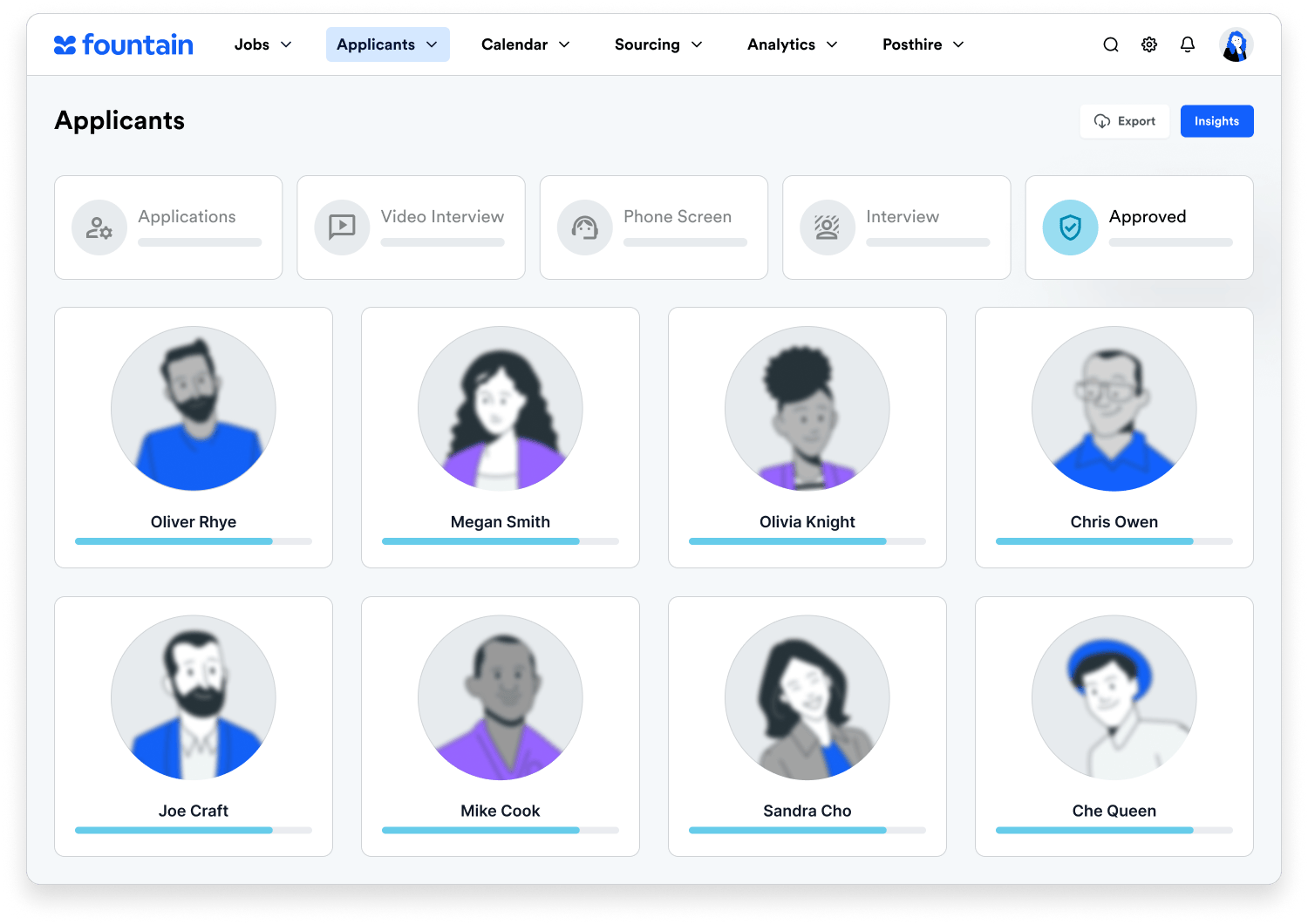Have you ever faced the daunting task of filling fill dozens, hundreds, or even thousands of job openings? If so, you’ve likely participated in high volume hiring, a style of hiring that differs from conventional, resume-based hiring.
High volume hiring is more than what the name denotes. Beyond hiring large numbers of workers at one time, it involves a process that looks very different from what is used for corporate or salaried positions. High volume hiring teams need to stay competitive as their industries are typically fighting to hire qualified workers from a smaller pool of applicants. To do this, they need the right tools, systems, and strategies, and they need to stay up to date with technology’s role in recruiting.
In this post, we’ll review what makes high volume hiring different from corporate hiring and identify the top needs, challenges, and processes for this unique style of hiring.
High volume hiring defined
High volume hiring—also called frontline hiring or hourly hiring—can be defined as the process of hiring large numbers of workers in a short amount of time. For example, a warehouse may need to staff operations with hundreds of workers, or a restaurant franchise may need to fill thousands of openings in multiple locations and geographies.

Hiring such a large number of people requires different processes compared to hiring a handful of corporate employees. Everything from hiring objectives and sourcing to workflows and communication can look vastly different when dealing with such a large influx of applicants.
To hire at scale, recruiters first need to identify key objectives, one of which should be to find a system that helps them hire as efficiently as possible. In a highly competitive job market, recruiting teams that hire high volumes of workers need a hiring process that moves candidates through the process swiftly but also ensures that those who are ultimately hired are qualified for the role. But more on systems later on…
Who needs high volume hiring?
How do you know whether you need to implement high volume hiring in your recruiting operations?
First, consider how many roles you need to fill on a regular basis. It may change at different points throughout your fiscal year, depending on demand, but at one point or another, the number of open roles you need to fill may stretch into the hundreds or even thousands.
Next, assess whether your industry deals with frequent turnover. If you tend to hire the majority of your workers at times of high demand (e.g., holiday seasons), you may experience high quit rates after the busy season has come and gone.
Finally, are your workers paid by the hour or do they receive a salary? Typically, teams that use high volume hiring processes hire hourly workers as opposed to salaried or corporate workers.
Who is responsible for high volume hiring?
The decision team that decides whether high volume hiring is necessary for recruiting operations can include the following people.

- VP or Head of Talent Acquisition—This person is usually interested in how hiring processes save time and resources, and how they directly affect hiring outcomes.
- CHRO or VP of Human Resources—The CHRO owns the wider hiring strategy and oversees recruiting and retention.
- Talent Acquisition Manager—At various levels of seniority, this member of the hiring team manages recruiters.
- Recruiter—The recruiters are in charge of the daily hiring operations. They’re the hands-on individuals who are on the front lines of recruiting, qualifying, and extending offers to candidates.
Common challenges of hiring at scale
High volume hiring can seem simple on the outside, but when recruiters are facing strict time and budget constraints, they need to be creative in devising a strategy that gets results.
Challenges that may prevent them from getting these results include the following.
- Manual processes. From moving candidates to next steps to sending documents to scheduling interviews, these manual tasks multiply fast when hundreds of applicants are concerned. This can bog down recruiters and lead to burnout and overload.
- Meeting candidate expectations. When candidates face a recruiting process that doesn’t meet them where they are—which is usually on their phones—they’re less likely to be interested in the process. They’re also expecting their path to employment to be fast and friction-free.
- Candidate drop-off. Candidates are more distracted than ever, and if they aren’t continuously engaged and informed, they’re likely to abandon the application process for another one that’s more efficient.
- Ineffective sourcing methods. A lack of resources and understanding of today’s frontline talent can lead to poor sourcing efforts and a shallow applicant pool.
- Poor visibility into processes. When you can’t collect and analyze data about your hiring funnel, how do you know it’s working? Many recruiting teams lack this important capability and therefore keep their processes unchanged for too long.
How the high volume hiring process works
As we’ve established, high volume hiring requires its own objectives, processes, and systems in order to source, qualify, and hire the right people for frontline or hourly roles. A standard high volume hiring process is likely to include the steps in this section.
Sourcing
Just like with corporate hiring, the first step of high volume hiring is to source qualified candidates. This is also the first step in building your own internal talent pool that you can tap into as future hiring needs arise.
Learn more: What is direct sourcing?
- Candidate screening. Job candidates need to be screened to identify whether they have the right background and qualifications to perform the job duties. The screening process can vary depending on the role and responsibilities, but it usually involves reviewing applications or resumes, possibly coupled with an interview.

- Interview scheduling. Once a candidate has been appropriately qualified, recruiters may want to schedule an interview as the final step in the high volume hiring process. This might be done with a phone call, via email, or via text message, with the interview taking place either in person or virtually.
- References and background checks. Before a final offer is extended, recruiters will complete background checks and confer with a candidate’s references to verify their identity and confirm their fit for the role.
- Hiring. The final hiring step is just that: to hire! With high volume hiring, this step is usually completed in a matter of days or weeks, as opposed to months for corporate positions.
- Onboarding. The onboarding process requires new hires to complete tasks like reading employee handbooks, signing documents, and submitting bank information in order to get paid. This sets up workers for their first day of work and beyond.
- Analyzing. In an ideal situation, hiring teams will be able to analyze their processes to identify areas for improvement. These metrics also can help convey to leadership the effectiveness of the process.
6 helpful tools for high volume hiring
To work through the necessary steps of the high volume hiring process, hiring teams need to connect with their recruiters and ensure the entire pipeline has the following characteristics and components.
High volume hiring strategy
Before you start your high volume hiring journey, you need to develop a strategy. This can involve assessing your needs with your recruiting team, taking stock of existing processes to look for gaps, and identifying goals you want your new systems to help you reach.
High volume hiring software
To meet the goals you identified in step one, you may find you need the help of technology. An applicant tracking system (ATS) can help streamline and condense all the steps of your hiring process into one easy-to-use platform.

Candidate-first approach
Candidates have more options than ever when it comes to hourly jobs, so recruiters need to ensure their hiring process puts their candidates first. Mobile-friendly messaging, personalization, and customization based on the candidates’ preferences will go a long way in attracting and keeping top talent.
Automation
To keep candidates moving through the hiring funnel fast, hiring teams need to implement automation where it makes the most sense. For example, document uploads, automatic background checks, and interview scheduling are a few steps that can be automated, creating more free time for recruiters.
Communication
Today’s job candidates are on the go, and that’s how they like their communication to be, as well. To keep candidates engaged and interested, create a steam of steady communication to remind them of appointments like interviews, nudge them to finish certain stages, and inform them of their status in the application process.
Customization and personalization
Despite being one in a million (sometimes literally), candidates still want to feel important. To achieve this, recruiters can benefit from building recruiting workflows that meet candidates’ expectations for speed and ease, while also infusing personalization where they can, such as in messaging and other communications.
The benefits of a high volume hiring solution
So what does all this look like in today’s world of high volume hiring? At the bare minimum, an efficient applicant tracking system can do a lot of this work for you.
A frontline ATS offers numerous operational advantages that give recruiters more time to focus on tasks that require human attention. By streamlining workflows, automating manual steps, and fast-tracking candidates through the process, recruiters can give their attention to improving the candidate experience.
Faster process also result in improved metrics like decreased time-to-hire, fewer drop-offs, and even cost savings.
Explore tips and tools to get the most out of high volume hiring.
How Fountain is different
Looking to drastically enhance your hiring process from end to end? Fountain is the leading solution to help you achieve hiring excellence. Recruiters have clear visibility into the process and can make changes as needs arise, depending on hiring fluctuations or learnings about what is working and what’s not.
Looking to scale? No problem. Fountain is custom-built to scale with you as your organization grows.

